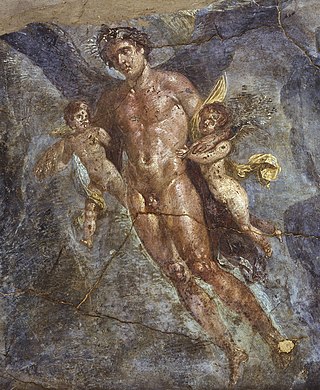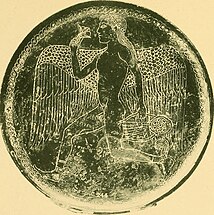
Hephaestus is the Greek god of artisans, blacksmiths, carpenters, craftsmen, fire, metallurgy, metalworking, sculpture and volcanoes. Hephaestus's Roman counterpart is Vulcan. In Greek mythology, Hephaestus was either the son of Zeus and Hera or he was Hera's parthenogenous child. He was cast off Mount Olympus by his mother Hera because of his lameness, the result of a congenital impairment; or in another account, by Zeus for protecting Hera from his advances.

In Greek mythology and religion, Zephyrus, also spelled in English as Zephyr, is the god and personification of the West wind, one of the several wind gods, the Anemoi. The son of Eos, the goddess of the dawn, and Astraeus, Zephyrus is the most gentle and favourable of the winds, and is also associated with flowers, springtime and even procreation. In myths, he is presented as the tender breeze, and he is known for his unrequited love for the Spartan prince Hyacinthus. Although he along with Boreas are the two most prominent wind gods, their role in mythology is relatively limited.

Aglaea or Aglaia is one of the three Charites in Greek mythology, also called the Gratiae (Graces) in Roman mythology.

In Greek mythology, Peneus was a Thessalian river god, one of the three thousand Rivers (Potamoi), a child of Oceanus and Tethys.
In Greek mythology, Deimos is the personification of fear. He is the son of Ares and Aphrodite, and the brother of Phobos. Deimos served to represent the feelings of dread and terror that befell those before a battle, while Phobos personified feelings of fear and panic in the midst of battle.

Typhon, also Typhoeus, Typhaon or Typhos, was a monstrous serpentine giant and one of the deadliest creatures in Greek mythology. According to Hesiod, Typhon was the son of Gaia and Tartarus. However, one source has Typhon as the son of Hera alone, while another makes Typhon the offspring of Cronus. Typhon and his mate Echidna were the progenitors of many famous monsters.

In Greek mythology, Peitho is the personification of persuasion. She is typically presented as an important companion of Aphrodite. Her opposite is Bia, the personification of force. As a personification, she was sometimes imagined as a goddess and sometimes an abstract power with her name used both as a common and proper noun. There is evidence that Peitho was referred to as a goddess before she was referred to as an abstract concept, which is rare for a personification. Peitho represents both sexual and political persuasion. She is associated with the art of rhetoric.

In ancient Greek religion and mythology, Iris is a daughter of the gods Thaumas and Electra, the personification of the rainbow and messenger of the gods, a servant to the Olympians and especially Queen Hera.

In ancient Greek religion and myth, Nemesis also called Rhamnousia, was the goddess who personified retribution for the sin of hubris; arrogance before the gods.
The following is a family tree of gods, goddesses, and other divine and semi-divine figures from Ancient Greek mythology and Ancient Greek religion.

The Dionysiaca is an ancient Greek epic poem and the principal work of Nonnus. It is an epic in 48 books, the longest surviving poem from Greco-Roman antiquity at 20,426 lines, composed in Homeric dialect and dactylic hexameters, the main subject of which is the life of Dionysus, his expedition to India, and his triumphant return to the west.
Achlys, in the Hesiodic Shield of Heracles, is one of the figures depicted on Heracles' shield, perhaps representing the personification of sorrow. In Homer, achlys is the mist which fogs or blinds mortal eyes. Her Roman counterpart Caligo was said to have been the mother of Chaos. In Nonnus's Dionysiaca, she seems to be a witch.
In Greek and Roman mythology, the primordial deities are the first generation of gods and goddesses. These deities represented the fundamental forces and physical foundations of the world and were generally not actively worshipped, as they, for the most part, were not given human characteristics; they were instead personifications of places or abstract concepts.

In Ancient Greek religion and mythology, the Erotes are a collective of winged gods associated with love and sexual intercourse. They are part of Aphrodite's retinue. Erotes is the plural of Eros, who as a singular deity has a more complex mythology.
In Greek mythology, Nicaea or Nikaia is a Naiad nymph of the springs or fountain of the ancient Greek colony of Nicaea in Bithynia or else the goddess of the adjacent lake Ascanius. She is the daughter of the river-god Sangarius and the mother-goddess Cybele. By the god of wine, Dionysus, she mothered Telete (consecration) and Satyrus, as well as other children.
Greco-Roman mythology features male homosexuality in many of the constituent myths. In addition, there are instances of cross-dressing, androgyny, and other themes which are grouped under the acronym LGBTQ+.

In Greek and Roman mythology, Aura is a minor wind goddess, whose name means "breeze". The plural form, Aurae is sometimes found to describe a group of breeze nymphs. According to the late antiquity writer Nonnus, Aura is the daughter of the Titan Lelantos and the mother, by Dionysus, of Iacchus, a minor deity connected with the Eleusinian mysteries, while Quintus Smyrnaeus makes the Aurae daughters of Boreas, the god of the north wind. Aurae was the title of a play by the Athenian comic poet Metagenes, who was contemporary with Aristophanes, Phrynichus, and Plato.

Charis is a goddess in Greek mythology. Her name is the singular form of the group called the Charites —or Gratiae (Graces) in Roman mythology—who are goddesses of charm, beauty, nature, human creativity and fertility. While the term Charis can refer to a member of this group generically, the name Charis is also used for specific goddesses in surviving sources.

In Greek mythology, Asteria or Asterie is a daughter of the Titans Coeus (Polus) and Phoebe and the sister of Leto. According to Hesiod, by the Titan Perses she had a single child, a daughter named Hecate, the goddess of witchcraft. Other authors made Asteria the mother of the fourth Heracles and Hecate by Zeus.
In Nonnus' Dionysiaca, Hymnus is a young shepherd who fell in love with the nymph Nicaea, was rejected by her, and ended up dying by her hand.






























